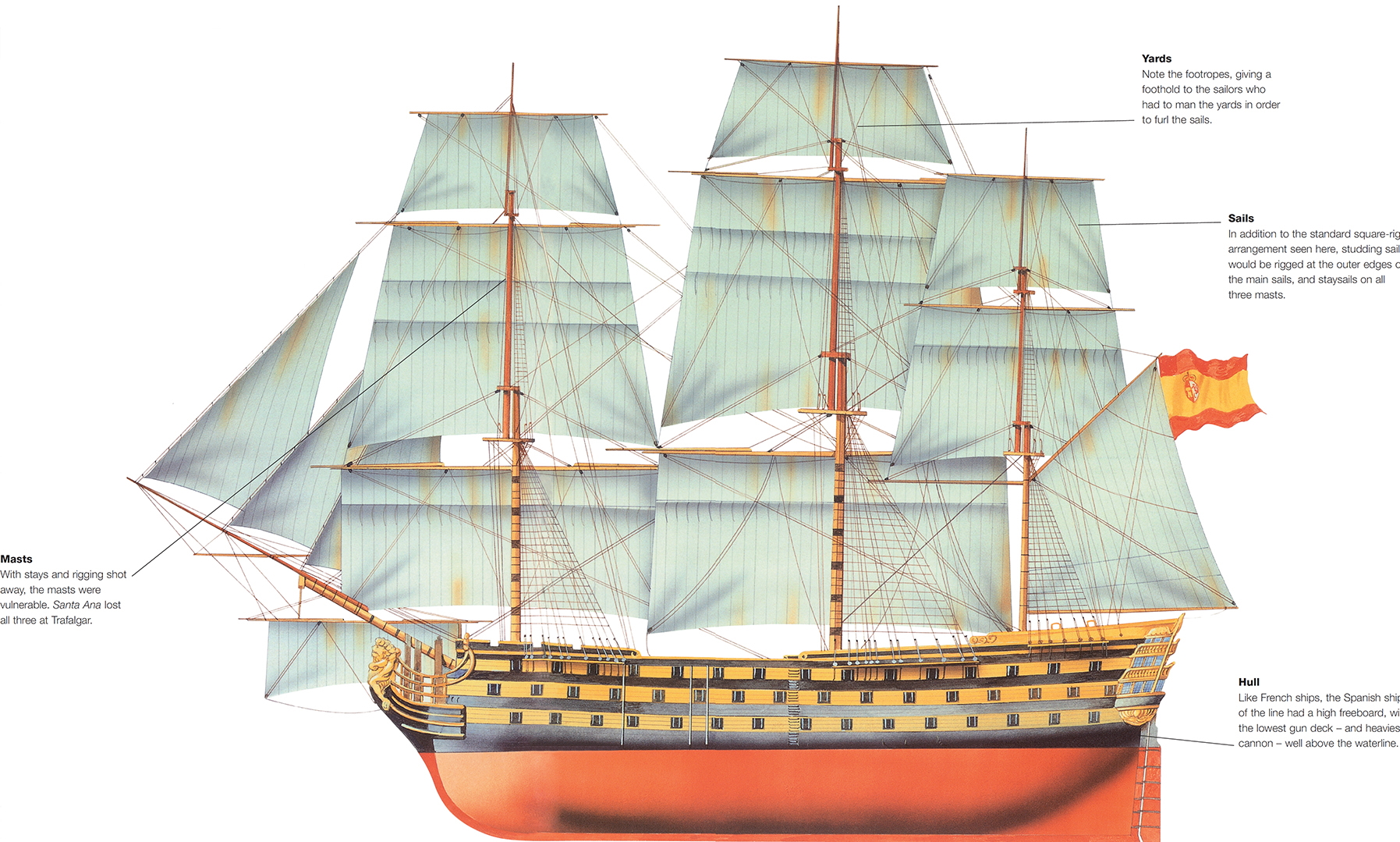
Santa Ana was a three-masted first-rate, with three decks of guns: the prototype for seven other ships built during the 1780s at Spanish and Cuban yards.
Santa Ana 1784 by San Martín – Artesanía Latina – Scale 1:84
A first-rate of 112 guns, Santa Ana was the first of a class of eight ships intended to provide the central strength of the Spanish Navy. It was Spain’s flagship at Trafalgar on 21 October 1805.
Naval architecture was a well-established science by the early eighteenth century. By mid-century Spanish shipbuilders were applying lessons learned from English and French designers to their own established techniques, particularly relating to wood treatment and construction methods. Jose Romero y Fernandez de Landa, Santa Ana’s designer, was a scientific builder, author of a textbook on the construction of warships, published in 1784.
Built at El Ferrol, the vessel was launched on 29 September 1784 and first put to sea on 24 November that same year, though not commissioned until 28 February 1785. It was based at Cadiz and maintenance work was done at the La Carraca Arsenal. In January 1787 it was dry docked at La Carraca, and in June 1791 was careened there and rotten timbers were replaced.
Santa Ana had seven anchors with a total weight of 20,457kg (45,100lb). Its ballast, in iron (small ball shots, and iron pieces) occupied around 20 per cent of the length, placed amidships and surrounded by stone ballast. An indication of the care and attention put into construction is given by the ballast-laying instructions. First tar was applied to the holding timbers, then a layer of zulaque (sticky clay or cement), 102mm (4in) thick was applied to the floor-heads. Ground brick was added in alternate layers with iron and fine mix to fill up the space up to 305mm (12in) above the floor-heads. Above this, only the mix of gravel and brick was laid to the heads of the first futtocks. The aim was to ensure that the ballast, around 81 tonnes (90 tons), was densely packed and could not shift in any direction with the pitching and rolling of the ship.
In 1794 the ship was given a full careen at La Carraca, rearmed in January 1797 and stationed at Cadiz. It was with the fleet blockaded in Cadiz in February 1798. In September that year it was careened again at La Carraca and copper sheathing was applied to the bottom. On 21 July 1799 it grounded at the Rota naval base but was refloated. A new keel was fitted in the course of 1800, and Santa Ana remained on service until 1802, when it was again disarmed. Most of its time until 1805 was spent disarmed either through being laid off or having repairs and maintenance; its periods of activity totalled approximately five years out of twenty-one. Disarming meant the removal of everything not integral to the hull structure, including the lower masts, bowsprit and ballast. Everything else was removed and stored away, including the rudder.
In January 1805 preparations for a new spell of active duty began. Careened in La Carraca in September of that year, it was newly rearmed and re-manned when it put to sea with the Combined Fleet, as flagship of the Spanish second-in-command.
In the Battle of Trafalgar, Santa Ana carried the flag of Vice-Admiral Alava and was captained by Jose Gardoqui. It seems it was painted white with black stripes, though some accounts state it was wholly black. Its position in the Combined Fleet’s line brought it against the British fleet’s lee division, headed by HMS Royal Sovereign, flagship of Vice-Admiral Collingwood, under whose drills the ship’s gunnery was the best in the British fleet. Royal Sovereign crossed just abaft of Santa Ana and fired a double-shotted broadside into the stern, which put 14 guns out of action and caused many casualties. The two ships were then locked together for a time, with Royal Sovereign against Santa Ana’s starboard bow, in a devastating cross-fire that continued for almost two hours. ‘They fought us pretty tightish’, reported a British midshipman. Santa Ana’s mizzen topmast was shot away, and after about an hour and a quarter all its three masts had fallen over. At about 14:20 it struck to Royal Sovereign.
Two days after the battle, Santa Ana was recaptured by a Spanish frigate squadron and towed back to Cadiz. When the French invaded Spain in 1808 it was still under repair and took no part in the Peninsular War. With a sister ship, Principe de Asturias, it was moved to Havana in 1810, but saw no further action. It eventually sank at the Havana Arsenal, in 1816.
Specification
Dimensions: Length 56.14m (184ft 2in), Beam 15.5m (50ft), Draught 7.37m (23ft), Displacement 2543 tonnes (2803 tons)
Rig: 3 masts, full-rigged ship
Armament: (1805) 30 36-pounder, 32 24-pounder, 10 8-pounder cannon; 10 48-pounder, 2 32-pounder, 6 24-pounder howitzers; 4 4-pounder swivel guns
Complement: 1000-plus